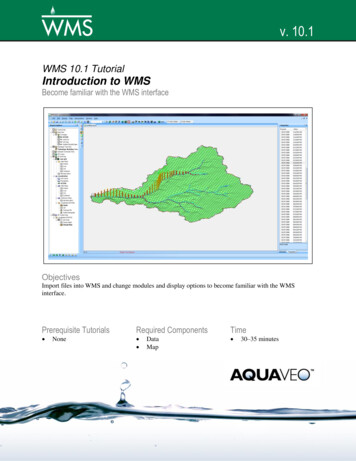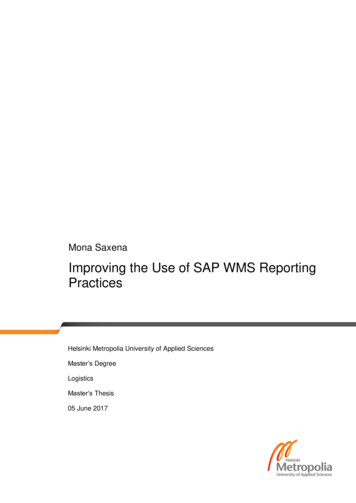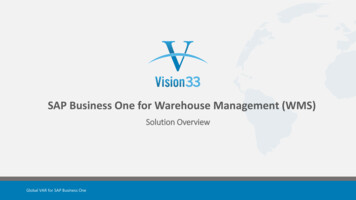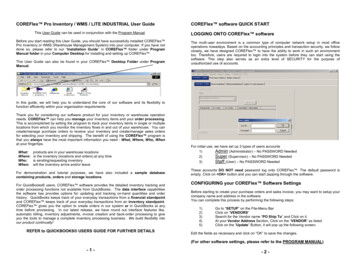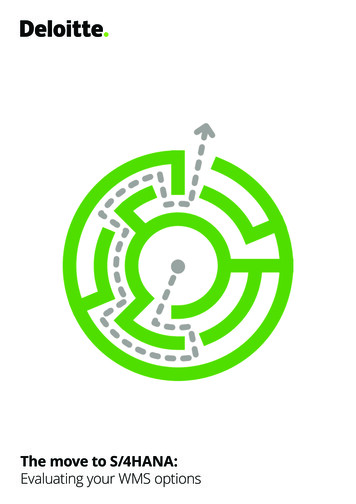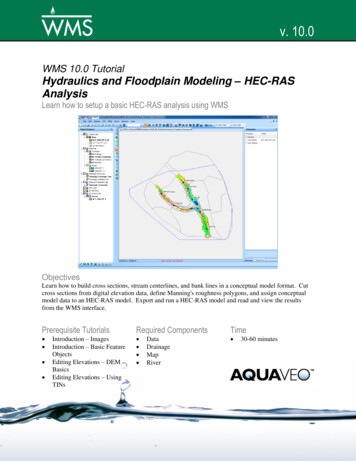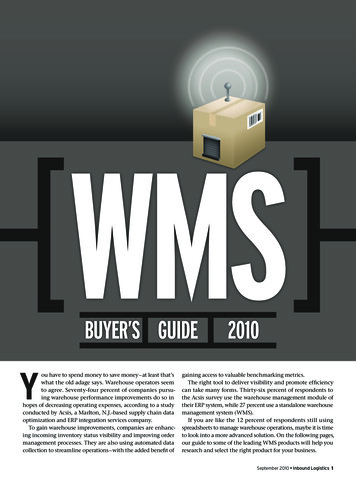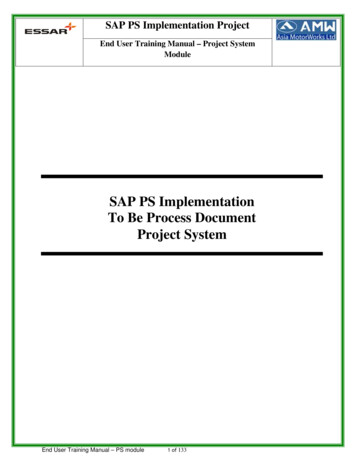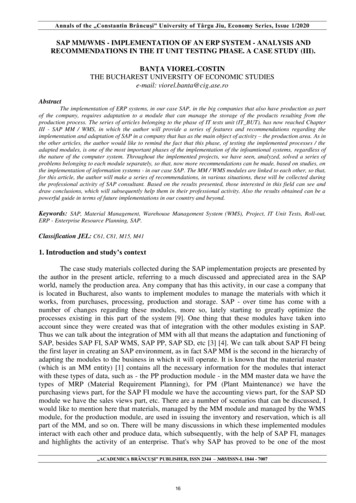
Transcription
Annals of the „Constantin Brâncuşi” University of Târgu Jiu, Economy Series, Issue 1/2020SAP MM/WMS - IMPLEMENTATION OF AN ERP SYSTEM - ANALYSIS ANDRECOMMENDATIONS IN THE IT UNIT TESTING PHASE. A CASE STUDY (III).BANȚA VIOREL-COSTINTHE BUCHAREST UNIVERSITY OF ECONOMIC STUDIESe-mail: viorel.banta@cig.ase.roAbstractThe implementation of ERP systems, in our case SAP, in the big companies that also have production as partof the company, requires adaptation to a module that can manage the storage of the products resulting from theproduction process. The series of articles belonging to the phase of IT tests unit (IT BUT), has now reached ChapterIII - SAP MM / WMS, in which the author will provide a series of features and recommendations regarding theimplementation and adaptation of SAP in a company that has as the main object of activity – the production area. As inthe other articles, the author would like to remind the fact that this phase, of testing the implemented processes / theadapted modules, is one of the most important phases of the implementation of the infoamtional systems, regardless ofthe nature of the computer system. Throughout the implemented projects, we have seen, analyzed, solved a series ofproblems belonging to each module separately, so that, now more recommendations can be made, based on studies, onthe implementation of information systems - in our case SAP. The MM / WMS modules are linked to each other, so that,for this article, the author will make a series of recommendations, in various situations, these will be collected duringthe professional activity of SAP consultant. Based on the results presented, those interested in this field can see anddraw conclusions, which will subsequently help them in their professional activity. Also the results obtained can be apowerful guide in terms of future implementations in our country and beyond.Keywords: SAP, Material Management, Warehouse Management System (WMS), Project, IT Unit Tests, Roll-out,ERP - Enterprise Resource Planning, SAP.Classification JEL: C61, C81, M15, M411. Introduction and study’s contextThe case study materials collected during the SAP implementation projects are presented bythe author in the present article, referring to a much discussed and appreciated area in the SAPworld, namely the production area. Any company that has this activity, in our case a company thatis located in Bucharest, also wants to implement modules to manage the materials with which itworks, from purchases, processing, production and storage. SAP - over time has come with anumber of changes regarding these modules, more so, lately starting to greatly optimize theprocesses existing in this part of the system [9]. One thing that these modules have taken intoaccount since they were created was that of integration with the other modules existing in SAP.Thus we can talk about the integration of MM with all that means the adaptation and functioning ofSAP, besides SAP FI, SAP WMS, SAP PP, SAP SD, etc [3] [4]. We can talk about SAP FI beingthe first layer in creating an SAP environment, as in fact SAP MM is the second in the hierarchy ofadapting the modules to the business in which it will operate. It is known that the material master(which is an MM entity) [1] contains all the necessary information for the modules that interactwith these types of data, such as - the PP production module - in the MM master data we have thetypes of MRP (Material Requirement Planning), for PM (Plant Maintenance) we have thepurchasing views part, for the SAP FI module we have the accounting views part, for the SAP SDmodule we have the sales views part, etc. There are a number of scenarios that can be discussed, Iwould like to mention here that materials, managed by the MM module and managed by the WMSmodule, for the production module, are used in issuing the inventory and reservation, which is allpart of the MM, and so on. There will be many discussions in which these implemented modulesinteract with each other and produce data, which subsequently, with the help of SAP FI, managesand highlights the activity of an enterprise. That's why SAP has proved to be one of the most„ACADEMICA BRÂNCUŞI” PUBLISHER, ISSN 2344 – 3685/ISSN-L 1844 - 700716
Annals of the „Constantin Brâncuşi” University of Târgu Jiu, Economy Series, Issue 1/2020successful solutions, for which they have chosen a very large series, from the companies operatingin this world. Throughout this implementation - for the company that produces and delivers,distributes high quality paints, a number of things have been reported, which the author discusses inthis article. In the implementation of SAP MM, a number of issues were considered, such as:missing settings (external material group, materisl group 1, 2, 4, characteristics, dimensions .),another high problem was the realization of two reports from a legal point of view (white spirit andpackaging reports), many aspects were discussed regarding ROH packaging & weight - checksolution for Romania, will be a querry, should be created, etc. Regarding the WMS part [2], theauthor discusses an essential thing in the implementation of this module - the necessity and theadaptability, on the ground, of the way of thinking of the SAP - how this thinking can beimplemented - see the space available, the capacity of the factory to produce - how the Romaniancompanies adapt to the way in which such a system, in our case SAP, is designed to work. If thereare still some aspects related to the problems encountered in the MM module, the WMS modulecan be mentioned: WMS translation in ENG / RO; split warehouse Rxx betweend normal and DGGsections; GR in WM Rxx (1) and Rxx (2) remains in 900 storage type, for Rxx (3) will beautomatically; Split Warehouse Rxx (3) betweend normal and DGG sections, this was requested bythe management of the company.2. Literature review conduct and resultsThe implementation of IT solutions has had over time various modalities of perception fromthe point of view of the specialized literature, modalities that had as purpose the highlighting of thedifferent implementation processes [6]. The author has done a series of research-based searches ininternational databases (IEEE Xplore (IEEE), ACM Digital Library (ACM), Science Direct (SD),SpringerLink (SL) and Google scholar (GS)) where in the database. keywords used ("ERPImplementation", "Factors and risks used in ERP Implementation", "Benefits and challengesdiscovered in ERP Implementation", "ERP", "ERP - Enterprise Resource Planning" was searchedfor articles that were of interest in this scientific work. The author verified a number ofapproximately 32 works, out of a total of 63 works (all articles that did not have a research purposemeant to bring the benefits, risks and risks, were excluded from the verification) [5].Figure 1 ERP - Development&Construction phase (source: compilation of the author)„ACADEMICA BRÂNCUŞI” PUBLISHER, ISSN 2344 – 3685/ISSN-L 1844 - 700717
Annals of the „Constantin Brâncuşi” University of Târgu Jiu, Economy Series, Issue 1/20203. The research scope and motivation: methodology and key steps received in the UATImplementation phase - SAP MM/WMS moduleThe reason of this article was to highlight the problems and risks faced by those who wishto adapt the two SAP modules - MM and WMS, but also to propose some regulations meant to helpthe two parties involved in such activities: SAP consultants on one side of the barricade, and thosewho invest in such systems, on the other part of the project implementation plan. Much data wascollected by the author throughout the implementation. In this case, the author relied on everythingthat is used in the collection of information, from completed questionnaires, minutes of themeeting, to discussions with those who were involved in carrying out the project [7].A series of data was collected, which, finally, grouped by areas of interest, are the basis ofwriting this article. As depicted in Figure 2, the tools used by the author in collecting informationwere very much based on providing some questions, with several answers, which were used bybusiness people to show what they understood about this project, as they thought it was helpful,what influence the system will have over the years [8], how it will help them in their daily work.The questionnaires were made available to the business environment, SAP consultants,project management, project beneficiary management. All have answered the questions asked, thusbeing able to highlight quantitatively the number of answers. Based on the data collected, ie theanswers offered to the author, we could draw conclusions regarding the topic of this article.Figure 2 ERP - Development&Construction phase – instruments used4. The case study – detailed survey of researchDetails regarding the context in which the case study was leadedMost articles aimed to highlight the steps that have been taken in implementing ERP-typeIT solutions. And here is the same thing: we have a company, a leader in its area of expertise,which is acquired by a large foreign concern, which aims, in the first year of the acquisition, tocompletely change its central IT system. The respective company has installed an efficient ITsystem, administered internally, with a series of adaptations made internally, by the existingprogrammers. From the beginning you can see the flexibility with which such a system can bemanaged. The parent company has an ERP - SAP system installed. Management decisions arepredictable - one wants to move to the target system, namely SAP. Now the question arises as to„ACADEMICA BRÂNCUŞI” PUBLISHER, ISSN 2344 – 3685/ISSN-L 1844 - 700718
Annals of the „Constantin Brâncuşi” University of Târgu Jiu, Economy Series, Issue 1/2020how this system should be installed: 1. Stand alone; 2. to integrate the Romanian company in theirsystems - rollout; 3. to install an SAP system in the cloud. The choice was one, from the point ofview of the author of this article, a predictable one: SAP rollout.Details about SAP UAT IT tests performed: problems occurred, mitigation plan,results in the SAP MM and SAP WMS areasIntegrated tests are a very important stage (here two types of tests can be defined: those ofIT type ie IT UAT and those of UAT type with business environment), both being used in theprojects of implementation of the SAP integrated system. In the figure 3 are describes the steps thateach SAP MM or WMS consultant must go through.They will have to complete, for each economic process, the necessary steps in the SAPsystem for the process to be successfully passed. Regarding the tests performed for the MMmodules - we can mention a number of difficulties encountered in SAP projects, namely: theachievement of master data - this must be done with the utmost care, knowing that all theinformation available here, will help, later, in almost all economic processes that use materials.Also here we can mention that regarding the WMS module - a series of rules must bediscussed very well by the functional consultants, knowing that here we are dealing with thestorage of materials, finished products, we will work with scanners, with a series of notifications,which will help us later in the WMS module.Figure 3 SAP MM/WMS-Input data excel sheet - SAP IT UAT (source: compilation of the author)The author collected a number of difficulties encountered during the implementation of theSAP system, in the following, we will detail 2 problems encountered on MM module:--Module: MM / Issue&Open list: White spirit report / Status: FS send it to Developmentteam, week 30, will be tested; Answer from developer: White spirit report, we havecompleted and it is with SAP Consultant for testingModule: MM / Issue&Open list: Packaging report / Status: "FS send it to Developmentteam, next week (31), will be tested; answer from developer: packaging report I amworking on it should be finished by week 31, I have completed the Packaging report in D05100. The transaction is ZMM PACK RO CONS. kindly test and let me know of anyconcerns.„ACADEMICA BRÂNCUŞI” PUBLISHER, ISSN 2344 – 3685/ISSN-L 1844 - 700719
Annals of the „Constantin Brâncuşi” University of Târgu Jiu, Economy Series, Issue 1/2020In order to carry out these series of articles, the author has completed a series of questionnaires,in the figure 4, he has detailed some of the questions existing in those files:Figure 4 SAP MM/WMS-Input data excel sheet - SAP IT UAT (source: compilation of the author)All the tests performed, their number, as well as the results are detailed below in the table 1:Table 1: The matrix of tests performed / teamConsultantsmember ofthe team(number)Number oftestsperformedNID 1Number ofTests performedTests performedTests performedtests whichwith expectedwith expectedwith expectedneed InputresultsresultsresultsdataER 1ER 2ER 3NID 2ER 50%50% ER 90%ER 100%SAP FI5282212 (1)14 (2)2 (3)SAP MM2373010 (1)20 (2)7 (3)SAP SD240288 (1)22 (2)10 (3) 1 MMSAP WMS11982 (1)13 (2)4 (3)SAP PP2473618 (1)22 (2)7 (3)Note: expected results (ER): 1 (ER 50 %) / 2. (ER 50 % and 90%); 3. (ER 100%);value NID 1 ER 1 ER 2 ER 3;value 20 (2) – means: 20 tests perfomed by 2 consultants (1 from MM team/1 from WMS) with expected erorsBased on the research done, we have a situation on the involvement of SAP MM/WMS consultants (2 seniors(MM/WMS) and 1 junior (MM)), the percentage of participation was 8% 17%.Figure 5 Percentage of participation in the / modules - SAP IT UAT„ACADEMICA BRÂNCUŞI” PUBLISHER, ISSN 2344 – 3685/ISSN-L 1844 - 700720
Annals of the „Constantin Brâncuşi” University of Târgu Jiu, Economy Series, Issue 1/2020Figure 6 Percentage of participation in the - SAP IT UAT (source: compilation of the author)5. ConclusionsThe conclusions that the author draws from this experience are that for each of the twomodules analyzed in this article, the involvement of more consultants would have been a real helpfor the whole project.
SAP, besides SAP FI, SAP WMS, SAP PP, SAP SD, etc [3] [4]. We can talk about SAP FI being the first layer in creating an SAP environment, as in fact SAP MM is the second in the hierarchy of adapting the modules to the business in which it will operate. It is known that the material master (which is an MM entity) [1] contains all the necessary information for the modules that interact with .
